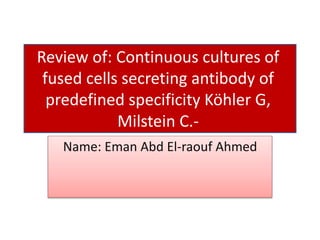
review articles
- 1. Review of: Continuous cultures of fused cells secreting antibody of predefined specificity Köhler G, Milstein C.- Name: Eman Abd El-raouf Ahmed
- 2. introduction THE manufacture of predefined specific antibodies by means of permanent tissue culture cell lines is of general interest. There are at present a considerable number of permanent cultures of myeloma cells1,2 and screening procedures have been used to reveal antibody activity in some of them. We describe here the derivation of a number of tissue culture cell lines which secrete anti- sheep red blood cell (SRBC) antibodies. The cell lines are made by fusion of a mouse myeloma and mouse spleen cells from an immunised donor. To understand the expression and interactions of the Ig chains from the parental lines, fusion experiments between two known mouse myeloma lines were carried out.
- 3. Important terms 1-An autoradiograph is an image on an x-ray film or nuclear emulsion produced by the pattern of decay emissions (e.g., beta particles or gamma rays) from a distribution of a radioactive substance. 2-The direct Plaque assay or Jerne technique, allows the enumeration in agar of cells producing antibodies to sheep RBC's or other erythrocytes. A suspension of spleen cells from a previously injected animal is mixed with the test erythrocytes and molten agar. After the agar has solidified the mixture is incubated at 37C for one hour, during which time the antibody producing cells will release antibody that will bind unto the antigen (the sheep RBC's). Subsequent addition of complement will lyse the antibody coated erythrocytes, causing the appearance of a clear plaque with the antibody producing cell in the middle.
- 4. Indirect Plaque Assay Erythrocytes will lyse in the presence of complement if the antibody is of the lgM class Those cells coated with antibody of the lgG class will not lyse because the antibodies are too far apart to bind complement. However, the system may be modified to detect lgG producing cells. The DPA direct plaque assay technique is DPA Method performed and the plaques are counted and marked. Anti-lgG is added and the plate is re-incubated with more complement. Any new plaques are the result of the IgG producing cells.
- 5. HAT Medium (hypoxanthine-amino pterion-thymidine medium) is a selection medium for mammalian cell culture
- 6. practical
- 8. Analysis of data –figure 1
- 9. Analysis of the practical figure 2
- 10. Analysis:
- 11. analysis
- 12. Steps for reviewing the article: Describe the derivation of anumber of tissue culture cell lines which secrete anti-sheep red blood cell antibodies. Each cell expresses only one of 2 alleles 2 antibody-producing cells are fused Products: both parental lines are expressed Experiment firmed by fusing 2 myeloma cells of the same mouth strain. *aim of the study: Provide the background for the derivation and understanding of antibody –secreting hybrid lines in which one of the parental cells is an antibody –producing spleen cell. Preparation: 2 myeloma cell lines ofBalB/c origin were used The first: pi Bul is resistant to 5-bromo-2-deoxyuridine The second: p3-x63Ag8 prepared from p3 cells Note: Equal numbers of cells from each parental fine fused using inactivated sedai virus. Result from the experiment: Shows the iso electric focusing pattern of the secreted products of different lines
- 13. Comment for the first result: Figure 1 A shows clones derived from different hybrid-sation experiments and from sub clones of one line are indistinguishable. Figure 1h:in which the heavy chain of P3 is no longer observed. *note: The cell line p-3 dies when exposed to HAT medium Spleen cells from an immunized mouse also die in growth medium. When both cells are fused by sendai virus and the resulting mixture is grown in HAT medium, surviving clones can be observed to grow and become established after a few weeks.
- 14. Second-figure: Figure 2a:used SRBC as immunogen which enabled us after culturing the fused lines, to determine the presence of specific antibody –producing cells by a plaque assay technique. Figure 2b: The hybrid cells were cloned in soft agar and clones producing antibody were easily detected by an overlay of SRBC and complement Figure 2-c: Individual clones were isolated and shown to retain their phenotype as almost all the clones of the derived purified line are capable of lysing SRBC. Figure 2d: The clones were visible to the naked eye
- 15. Figure 3 Figure 3 a:shows the IEF pattern of the material secreted by 2 such sp hybrid clones The IEF bands derived from the parental P3 line are visible in the pattern of the hybrid cells ,although obscured by the presence of a number of a new bands.
- 16. Notes: Cell fusion technique are a powerful to produce specific antibody directed against a predetermined antigen. Three different fusion experiments were successful in producing a large number of antibody producing cells. 3 weeks after the initial fusion 3%clones were positive by the direct plaque assay. The cloning efficiency in the experiment was 50% In another experiment: the proportion of positive clones (0.2%) In the third experiment: the hybrid population was studied by limiting dilution analysis.
- 17. Figure.4 Shows the inhibition of SRBC lysis by a specific anti –IgM antibody.
- 19. Thanks
